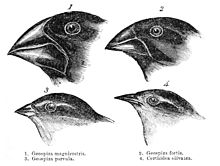| Darwin's finches | |
|---|---|

| |
| Large ground finch, Medium ground finch Small tree finch, Green warbler-finch | |
| Scientific classification | |
| Domain: | Eukaryota |
| Kingdom: | Animalia |
| Phylum: | Chordata |
| Class: | Aves |
| Order: | Passeriformes |
| Superfamily: | Emberizoidea |
| Family: | Thraupidae |
| Groups included | |
Darwin's finches (also known as the Galápagos finches) are a group of about 18 species of passerine birds.[1][2][3][4] They are well known for being a classic example of adaptive radiation and for their remarkable diversity in beak form and function.[5] They are often classified as the subfamily Geospizinae or tribe Geospizini. They belong to the tanager family and are not closely related to the true finches. The closest known relative of the Galápagos finches is the South American dull-coloured grassquit (Asemospiza obscura).[6] They were first collected when the second voyage of the Beagle visited the Galápagos Islands, with Charles Darwin on board as a gentleman naturalist. Apart from the Cocos finch, which is from Cocos Island, the others are found only on the Galápagos Islands.
The term "Darwin's finches" was first applied by Percy Lowe in 1936, and popularised in 1947 by David Lack in his book Darwin's Finches.[7][8] Lack based his analysis on the large collection of museum specimens collected by the 1905–06 Galápagos expedition of the California Academy of Sciences, to whom Lack dedicated his 1947 book. The birds vary in size from 10 to 20 cm (4 to 8 in) and weigh between 8 and 38 grams (0.3 and 1.3 oz). The smallest are the warbler-finches and the largest is the vegetarian finch. The most important differences between species are in the size and shape of their beaks, which are highly adapted to different food sources. Food availability was different among the islands of the Galapagos and could also change dramatically due to natural events such as droughts. The birds are all dull-coloured. They are thought to have evolved from a single finch species that came to the islands more than a million years ago.[9]
- ^ Grant & Grant 2008, p. 3
- ^ Marsh, Geoff (11 February 2015). "Darwin's iconic finches join genome club". Nature. 518 (7538): 147. Bibcode:2015Natur.518..147M. doi:10.1038/518147a. PMID 25673391.
- ^ Koffmar, Linda (12 February 2015). "Evolution of Darwin's finches and their beaks". Uppsala University, Sweden. Archived from the original on 2018-04-24. Retrieved 2018-04-24.
- ^ Soons, Joris; Herrel, Anthony; Genbrugge, Annelies; Aerts, Peter; Podos, Jeffrey; Adriaens, Dominique; Witte, Yoni de; Jacobs, Patric; Dirckx, Joris (12 April 2010). "Mechanical stress, fracture risk and beak evolution in Darwin's ground finches (Geospiza)". Philosophical Transactions of the Royal Society B: Biological Sciences. 365 (1543): 1093–1098. doi:10.1098/rstb.2009.0280. PMC 2830229. PMID 20194171.
- ^ Podos, Jeffrey; Nowiki, Stephen (2004). "Beaks, Adaptation, and Vocal Evolution in Darwin's Finches". BioScience. 54 (6): 501–510. doi:10.1641/0006-3568(2004)054[0501:baavei]2.0.co;2.
- ^ Sato A, Tichy H, O'hUigin C, Grant PR, Grant BR, Klein J (March 2001). "On the Origin of Darwin's Finches". Mol. Biol. Evol. 18 (3): 299–311. doi:10.1093/oxfordjournals.molbev.a003806. PMID 11230531.
- ^ Lack, David (1947). Darwin's Finches. Cambridge University Press. Reissued in 1961 by Harper, New York. Reissued in 1983 by Cambridge University Press, ISBN 0-521-25243-1.
- ^ Steinheimer 2004, p. 300
- ^ For Darwin's finches, beak shape goes beyond evolution Leah Burrows, Harvard University: News and Events. November 12, 2021